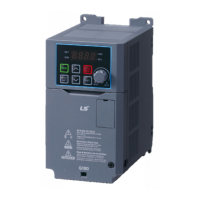9.2 Troubleshooting Fault Trips
When a fault trip or warning occurs due to a protection function, refer to the following
table for possible causes and remedies.
The load is greater than the motor’s
rated capacity.
Replace the motor and inverter with
models that have increased
capacity.
The set value for the overload trip
level (Pr.21) is too low.
Increase the set value for the
overload trip level.
There is a motor-load connection
problem.
Replace the motor and inverter with
models with lower capacity.
The set value for underload level
(Pr.29, Pr.30) is less than the
system’s minimum load.
Reduce the set value for the
underload level.
Acc/Dec time is too short, compared
to load inertia (GD2).
The inverter load is greater than the
rated capacity.
Replace the inverter with a model
that has increased capacity.
The inverter supplied an output while
the motor was idling.
Operate the inverter after the motor
has stopped or use the speed
search function (Cn.60).
The mechanical brake of the motor is
operating too fast.
Check the mechanical brake.
A ground fault has occurred in the
inverter output wiring.
The motor insulation is damaged.
Deceleration time is too short for the
load inertia (GD2).
Increase the deceleration time.
A generative load occurs at the
inverter output.
The input voltage is too high.
Determine if the input voltage is
above the specified value.
A ground fault has occurred in the
inverter output wiring.
The motor insulation is damaged.
The input voltage is too low.
Determine if the input voltage is
below the specified value.
A load greater than the power
capacity is connected to the system
(e.g., a welder, direct motor
connection, etc.).
Increase the power capacity.
The magnetic contactor connected to
the power source has a faulty
connection.
Replace the magnetic contactor.

